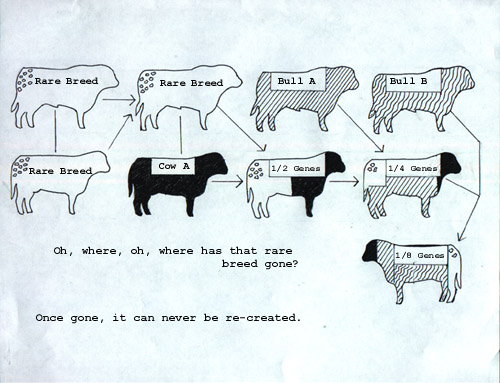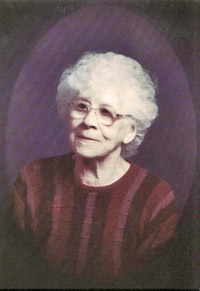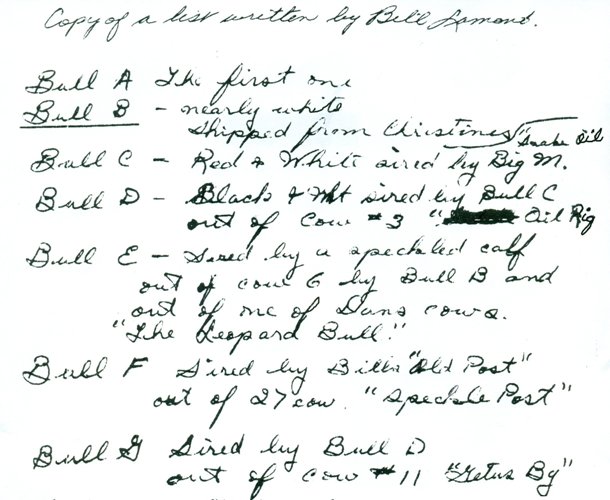 |
 |
![]()
|
Bill Lamont, Stockman
Bear in mind, that
statement was made in the late 1950's when few books had been written
on the subject - and there was very little money around with which to
buy them anyway! One picked up skill and knowledge along the way, working
with animals. Bill was one of the first to try psychology on both horses
and cattle. One of the things he would say was "Stop punishing
the animal when it's doing what you want." This was often if he
saw someone still beating a cow when it was already going up the loading
chute. After spending some time in the R.C.A.F almost at the end of World War II, he married Eileen Pike from north of Waseca, Saskatchewan. They spent some time in Brantford, Ontario where Bill and brother-in-law Gerald worked in the Massey-Harris Tractor Plant. In 1946 Bill and Eileen moved to a farm near Big Gully Creek, north of Maidstone, and in 1959 they moved to a farm west of Maidstone. Over the years, with a lot of hard work, they acquired a very good herd of Black Angus cattle, using the best bulls they could get. At times Bill would have up to seven bulls "loaned out"; Black Angus, and then Speckle Park to people starting to raise them. One wonders if that generosity was taken for granted and forgotten. He would also have a couple at home for his own herd. At times people would ask Eileen, "What is Bill doing?" "Checking the cattle." She'd reply. "But he's been standing there for the longest time, just looking at them!" "Well, he's still checking them." She'd say again. Bill raised horses and could tell numerous stories about the dozens he trained to saddle and harness for himself and others. He would say, however, that he could train the horses, but not the owners. He also stood some fine stallions of different breeds, but eventually raised Appaloosas. A top cattleman, Bill had good fences, a neat yard and a clean stable on his Saskatchewan property. He could bring cattle and horses through the winters looking good, even when feed supplies were short or poor. Bill and Eileen were, and are, known for their hospitality. Many have been the people they have had as houseguests or as visitors and they have a wide circle of friends and acquaintances. With humour, honesty and fortitude, they worked hard through the lean start-up years. They often helped out younger people, often those with families. This sometimes turned out well, but there were those who took advantage of them. The Lamonts started the first riding club in the area, The Hill and Gully Riders. Although it was successful, it was before there was much money around, which made quite a difference, compared to what can be done now. Bill developed "farmers lung" and in 1986 he and Eileen moved to a beautiful home near Salmon Arm in interior British Columbia. This meant they had to quit working with their Speckle Park cattle, before a large enough base was created, and trust them to others. They have been drawn into yet another circle of friends, not forgetting true friends from the past. Travelling friends always drop in on them. Among Eileen's many interests are diet, fitness, music, art and gardening. She was soon winning scores of prizes at flower and art shows. Bill enjoys all the numerous sales, antique stores and "flea markets" in the area and has little lime for leatherwork and braiding or woodwork - crafts he used to pursue on those long winter nights near the banks of Big Gully Creek. Besides, he spent a lot of time building neat fences and doing other maintenance work during the first years after they arrived. He and Eileen still keep in touch with the livestock world to some degree. Bill did take two of his young Appaloosas out to British Columbia however, they were eventually sold. In 1998 he and George Wilson took delivery of cattle from the herds of Maureen Bexson, Ed and Shirley Melchoir, Kim Tucker and Tom Lamont. It is hard to believe that there are people today who would try to put down what Bill accomplished, or pretend that he did not possess a fund of experience and knowledge. The breed of cattle he developed is capable of standing against other breeds. In 1973, three Speckle Park cattle steers were bought from the Lamonts and fitted by the Glasmans, near Russel, Manitoba, for the Royal Winter Fair in Toronto. The steers placed second in the group of three market steers, and third, sixth and ninth individually. Speckle Park have won beef quality awards and have done quite well in carcass classes. They do well as 4-H animals, especially since they have a docile nature. They are good feed converters, most calve with ease and mature cattle are easy keepers and milk well. Calves are approximately 75 pounds at birth and should wean at 500 to 600 pounds. Mature cows are around 1400 pounds and mature bulls are 2000 pounds and over. The aim is that yearlings should be over 1000 pounds. Bill had a business selling dressed beef as do some breeders today and he had many return customers for the tender, tasty beef. Speckle Park cattle should have a moderate frame; they were never meant to be big-boned. The head should be short, but not overly fleshy, resembling the Galloways, or the Angus when it had the noticeably somewhat dished face. They should have strong, straight backs. This was one of the characteristics of the breed and a most important one. A weak back is most undesirable over the hips where the choice cuts are produced. A high tailhead is also undesirable. The animal should be broad when viewed from behind. Although the shoulders and sides are predominantly black, the white line on the back should open up to speckles, especially over the hips and rump. The face should be black, or to quote Debbie Ralston "frosted black". Sometimes a white "tear drop" will be below the eye and white "garters" around the hocks. A black or dark frosted face is mandatory on bulls. Animals which come out white or leopard spotted must still have black points, that is to say, black ears, nose, feet and around the eyes. Bill did invent the slogan "The Balanced Beef Breed with the Colour Bonus" after a comment by Doug Staniforth, long-time butcher. "The bull is the prominent breeding animal, so should be strongly marked with as black a face as possible." (A comment by a former C.S.P.A member.) "In reference to the 'breed improvement', I don't feel that 'Speckle Park Colour' constitutes breeding status. As we all know, there is much more to it, besides, I thought we already had the best breeding stock within the organization. If the association is to grow in strength (district status) it has to be through type-to-type breeding. Strict rules and ethics must be maintained to keep Canadian Speckle Park Association from being cut back by years (or possible destroyed)." (A former C.S.P.A member writing in 1994 about the suggestion that animals of similar coat pattern, ancestry unknown, should be allowed into the breed.) Bill did stress that his breed, if ever in the show ring or on display, should be shown as natural as possible, with just enough clipping to trim off long hairs that might blur the animals outline. Nor should the tail be altered. Eileen once posed the question, "Why did some people buy our animals because they liked what they saw, then try to change them?" From V. Porter's "Cattle: Breeds of the World." - "It is easier to destroy resources than create them. Once genes are lost, through any reason such as DILUTION, the possibility of successfully breeding the original animal is critically reduced." The first person from Livestock Records in Ottawa to see the Speckle Park Cattle said "If these cattle don't make it, it won't be the fault of the cattle." No breed of cattle was ever developed in a hurry. All breeds of cattle need good cattleman to keep the breed viable, for poor feeding, indifferent care and the wrong choice of breeding stock could soon destroy even established breeds. Speckle Park cattle, in that respect, are no different from any other breed. This breed, all breeds, need good stockmen and women of the calibre of Bill and Eileen Lamont.
Mary Lindsay, Originator of the Lineback Cattle
Christine Pike took a photograph of BULL B at her home before he was shipped in 1974. He was the sire of the The Leopard. Bull B wasn't colored enough and by age 3 as seen here, was so fat he practically waddled. The Bill who owned the Angus bull Old Post(picture is on the website) was Bill Dillabough, Coleville, Old Post sired Speckle Post. Big M was Biffles Emulous, the Angus bull which, unknown to Bill Lamont, carried red genes. He sired BULL C, red and white speckle. BULL C was used a little, then shipped. He sired BULL D, Oil Rig. BULL C was called Snale oil because Bill had been "snake oiled" about Big M's genetics. A good bull but the red genes were not mentioned when he bought the semen. Jim Haydock of Lenwall District, southeast of Hillmond, was the A1 technician. So here we have the first bulls, Angus crossed with Lineback from Mary Lindsay were the sires and dams.
|
 While
still quite young, Bill Lamont was known to have a way with horses.
The gifted trainer, Jack Sproule, said Bill was the best young horseman
with whom he had ever worked.
While
still quite young, Bill Lamont was known to have a way with horses.
The gifted trainer, Jack Sproule, said Bill was the best young horseman
with whom he had ever worked.

